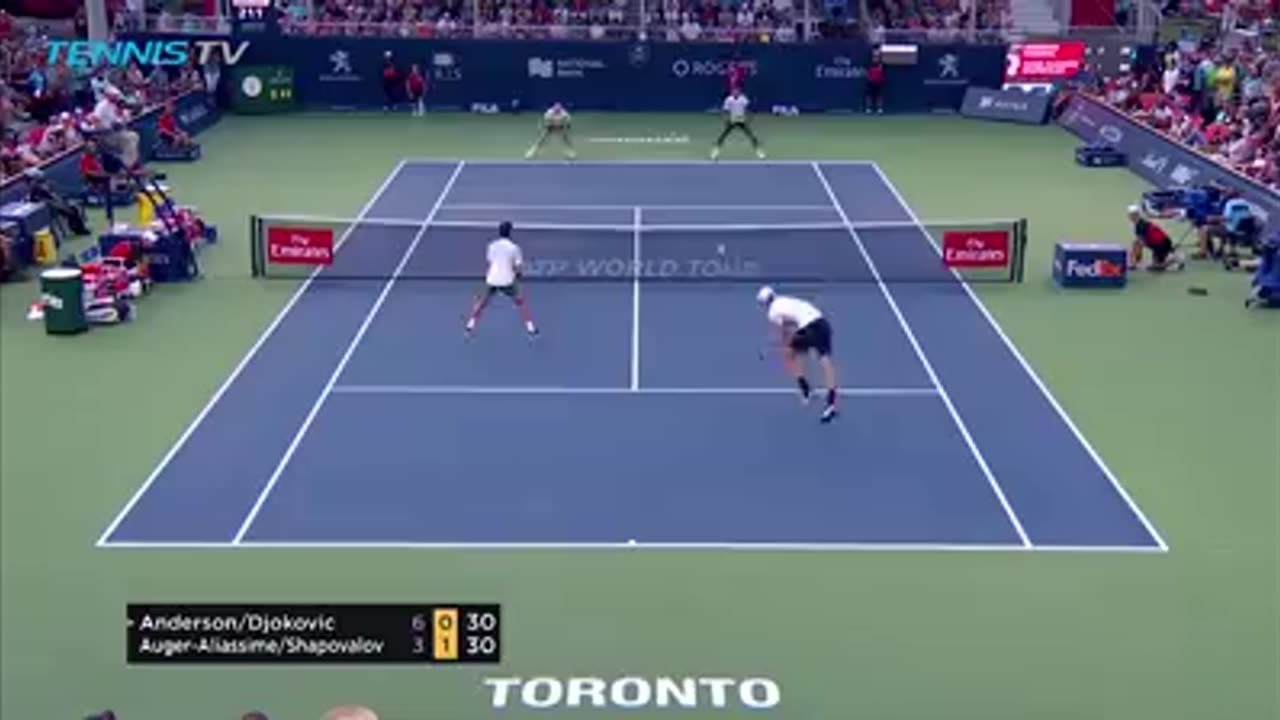Premium Only Content

Tennis Insane atp doubles railies
Tennis is a sport of finesse, power, strategy, and endurance. It stands out as one of the few games that blends individual brilliance with physical agility in such a compelling way. Played and loved worldwide, tennis is a global sport that transcends culture, language, and borders. Whether it's the roar of a Wimbledon crowd or a local clay court tournament, tennis delivers high-stakes drama, athleticism, and mental fortitude. This essay explores the rich history of tennis, its rules and playing styles, legendary players, major tournaments, and the profound cultural impact the sport has made over the centuries.
History of Tennis
Tennis has a history that stretches back many centuries. Its earliest origins are believed to be in 12th century France, where a game known as “jeu de paume” was played by monks using their hands to hit a ball over a rope. Eventually, racquets were introduced, and the game evolved. By the 16th century, it had become known as “tennis” and was popular among European nobility. King Henry VIII of England was known to be a passionate player, and indoor courts were built for the aristocracy.
Modern lawn tennis, the version we know today, was codified in England in the 19th century. Major Walter Clopton Wingfield is credited with standardizing the rules and promoting the sport as a game that could be played on lawns. In 1877, the All England Lawn Tennis and Croquet Club held the first Wimbledon Championship, which became the most prestigious tennis tournament in the world.
Over the decades, tennis evolved from a pastime for the elite into a competitive, professional sport. It expanded globally with the establishment of international tournaments and governing bodies such as the International Tennis Federation (ITF), founded in 1913.
Basic Rules and Format
Tennis is typically played in singles (one-on-one) or doubles (two-on-two) formats. The objective is to hit the ball over the net into the opponent’s side of the court in a way that they cannot return it. Points are scored when a player fails to return the ball within the lines of the court.
Scoring System
Tennis has a unique scoring system:
Points are counted as 15, 30, 40, and game.
If both players reach 40, the score is called “deuce.” A player must then win two consecutive points to win the game: first to "advantage," and then the game.
Six games win a set, provided there’s a margin of two games. A 6–6 tie results in a tiebreak.
Matches are best of three or best of five sets, depending on the tournament.
Playing Surfaces
The surface of the court significantly influences the game:
Clay courts (e.g., French Open) slow down the ball and produce high bounces.
Grass courts (e.g., Wimbledon) allow for fast, low-bouncing play.
Hard courts (e.g., US Open, Australian Open) offer a balance between speed and bounce.
Each surface demands different playing styles and strategies, adding depth and variety to the sport.
Playing Techniques and Styles
Tennis players employ a variety of strokes and techniques, such as:
Forehand and backhand: Basic groundstrokes hit with either the dominant or non-dominant side.
Serve: The starting shot of each point, which can be a weapon when delivered with power and accuracy.
Volley: A shot hit before the ball bounces, typically used near the net.
Lob and drop shot: Tactical plays used to disrupt an opponent’s rhythm.
Players also vary in style—some are aggressive baseliners, others serve-and-volley, while some rely on defensive play and consistency. This diversity in style leads to intriguing matchups and rivalries.
Grand Slam Tournaments
Tennis has four major tournaments, known as the Grand Slams:
1. Australian Open (hard court, January)
2. French Open (clay, May–June)
3. Wimbledon (grass, June–July)
4. US Open (hard court, August–September)
Winning all four in a calendar year is termed a Calendar Grand Slam, an extremely rare feat achieved by only a few players. These tournaments are not only prestigious but also offer the most ranking points and prize money.
Iconic Tennis Players
Tennis has produced some of the most iconic athletes in the history of sports.
Men’s Tennis Legends
Roger Federer: Known for his grace, technique, and dominance on grass, Federer has 20 Grand Slam titles and is regarded as one of the greatest players of all time.
Rafael Nadal: The “King of Clay,” Nadal’s relentless energy and 14 French Open titles have cemented his legacy.
Novak Djokovic: Arguably the most complete player, Djokovic has held all four Grand Slam titles simultaneously and surpassed both Federer and Nadal in total Slams.
Rod Laver: The only player to win the Calendar Grand Slam twice (1962 and 1969), Laver is a legendary figure in tennis history.
Women’s Tennis Icons
Serena Williams: With 23 Grand Slam singles titles, Serena dominated women’s tennis with her powerful game and unmatched determination.
Steffi Graf: The only player to achieve the Golden Slam (winning all four majors and Olympic gold in a single year, 1988).
Martina Navratilova: Known for her versatility and longevity, she won 18 Grand Slam singles titles and a record 31 doubles titles.
Margaret Court: Holds the record for the most Grand Slam titles (24), an achievement that still stands.
These players not only achieved greatness but also inspired generations with their dedication, sportsmanship, and resilience.
Evolution of Tennis Equipment and Training
Tennis has seen significant changes in equipment. Wooden racquets have been replaced with lighter, stronger materials like graphite and carbon fiber, allowing players to hit with more power and spin. String technology has also evolved, enabling more control and variation in shots.
Training methods have become more scientific, with players focusing on physical conditioning, nutrition, mental coaching, and data analytics. This has contributed to the increased intensity and longevity of modern tennis careers.
Tennis in the Modern Era
Tennis today is a multi-billion dollar industry with global viewership and professional tours for both men (ATP) and women (WTA). It’s one of the few sports where men and women compete on nearly equal footing in terms of visibility and earnings, especially in Grand Slam events where prize money is equal.
The rise of new talents like Carlos Alcaraz, Iga Świątek, Jannik Sinner, and Coco Gauff signals a promising future. These players bring freshness, innovation, and athleticism that keep fans excited and engaged.
Cultural and Social Impact
Tennis has played a vital role in breaking social barriers:
Althea Gibson and Arthur Ashe were pioneers for Black athletes in a predominantly white sport.
Billie Jean King fought for gender equality and helped launch the WTA.
The Battle of the Sexes match in 1973 (King vs. Bobby Riggs) was a landmark moment in the women’s rights movement.
Naomi Osaka and Venus and Serena Williams have used their platforms to speak on mental health, race, and equality.
Tennis has also inspired art, literature, and fashion. Its iconic moments, from marathon matches to emotional victories, are etched in public memory and often symbolize resilience and excellence.
Challenges and the Road Ahead
While tennis has achieved global popularity, it faces challenges such as:
Scheduling conflicts and long seasons that strain players.
The need for more accessible opportunities in developing countries.
Balancing tradition (like Wimbledon’s dress code) with modernization.
Sustainability concerns around travel and tournament infrastructure.
Efforts are being made to address these issues. For instance, there’s an increasing push for environmental consciousness in tournament operations and more support for players outside the top rankings.
Conclusion
Tennis is more than just a sport; it’s a stage for stories of determination, rivalry, passion, and global unity. From its aristocratic roots to its current status as a sport of the people, tennis has continually evolved. It showcases the best of athletic skill and mental strength while influencing culture, society, and even politics. Whether watched on a sunny afternoon at Roland-Garros or played casually at a local court, tennis continues to be a source of inspiration and joy to millions around the world.
---
Would you like this in a specific format (like PDF or Word), or want to add citations, images, or a particular focus (e.g., youth development or coaching)? /storage/emulated/0/Download/google6170e9d15902cb37 (6).html
/storage/emulated/0/Download/google6170e9d15902cb37 (6).html
-

PandaSub2000
5 days agoLIVE 9:30pm ET | MADISON VR (The Scariest Game Ever Made)
9.88K1 -
 2:34:32
2:34:32
Badlands Media
5 days agoCODEX 9/11
270K214 -
 1:53:43
1:53:43
Nerdrotic
6 hours ago $0.27 earnedMysteries of 3I/ATLAS | Forbidden Frontier #113
41.6K4 -
 2:04:21
2:04:21
vivafrei
1 day agoEp. 278: D.C. Peace Wave! Big Tish & Nipple Judge SPANKED! "Maryland Man" Trafficker FREE & MORE?
90.7K114 -
 LIVE
LIVE
Damysus Gaming
2 hours agoBorderlands 3 - Part 8 - FL4K Time | Children of the Vault be Warned!
62 watching -
 1:30:28
1:30:28
Patriots With Grit
6 hours agoWhat You Should Know About Harmful Vaccine Ingredients And What To Say To Your Doctor, Pediatrician, Health Department or School When They Pressure You, Your Kids Or Your Family Members | Dr. Bryan Ardis, D.C.
11.7K5 -

This is the Ray Gaming
2 hours ago $0.01 earnedSunday Night Live with the Boys | Rumble Premium Creator
6.38K -
 2:02:16
2:02:16
ItsMossy
3 hours ago🍃NEW MIC WHO THIS🍃DRIVING SIM GO BRRR🍃420 SESH🍃
3.86K1 -
 LIVE
LIVE
THOUGHTCAST With Jeff D.
2 hours agoSunday night Fortnite With ScottishVikingGaming & crew
25 watching -
 3:11:45
3:11:45
a12cat34dog
3 hours agoSOLID DAWG RETURNS :: METAL GEAR SOLID :: 1998 IS UNFORGIVING {18+}
6.94K1